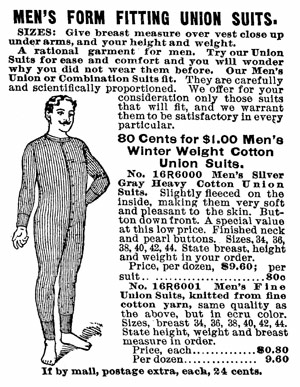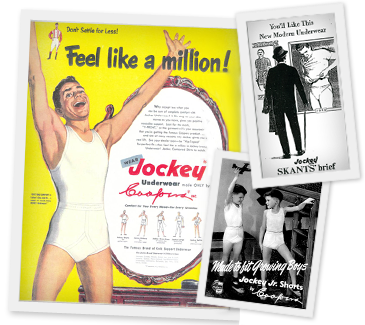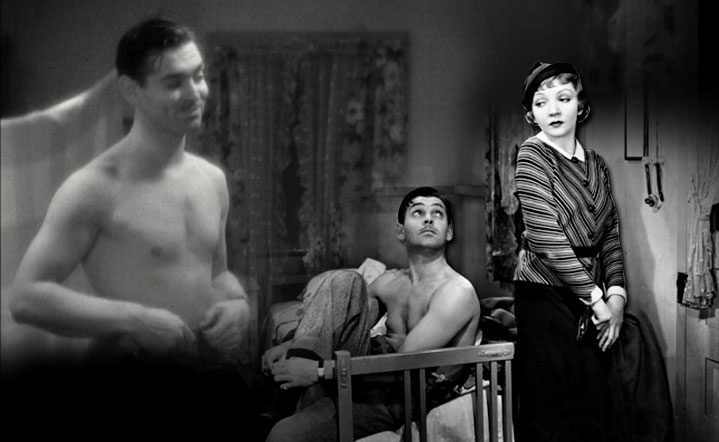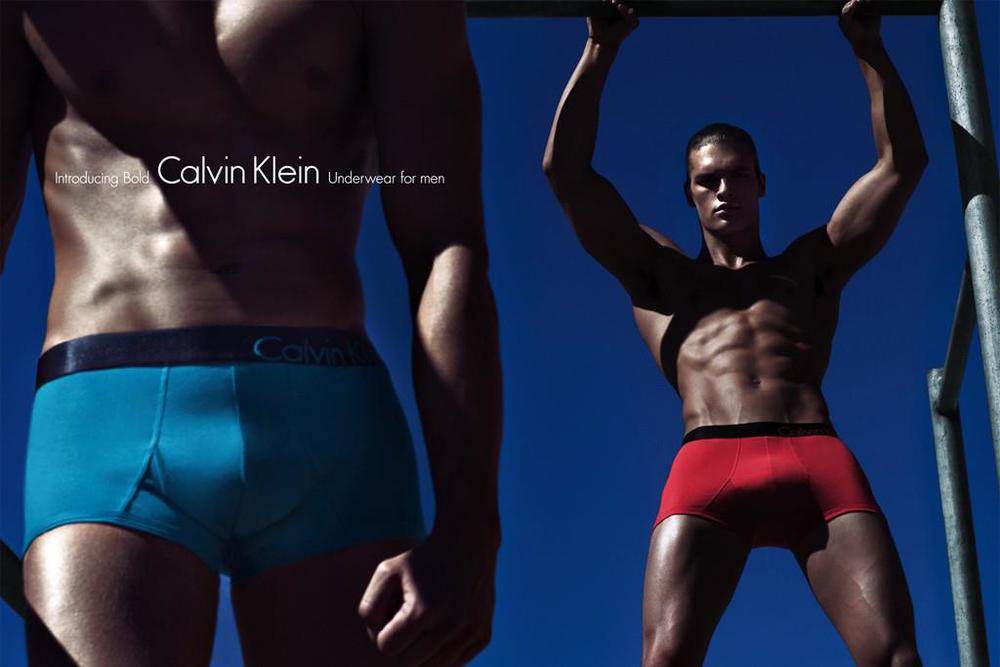Ask Anna: Men's Undergarments


Men’s underwear just seems so much less, well, complicated than women’s underwear. But just how old is that age-old question, “boxers or briefs?” We know that men haven’t always been the gender with less freedom in fashion, so have their undergarments always been so … unfancy?
 They certainly started out that way. Several thousand years ago, undergarments were actually outerwear – very simple, belted pieces of fabric that men would throw on when they were working in the fields or otherwise going about their day in public. You know these garments as “loincloths” (think of them as prehistoric sweatpants). Different cultures, of course, had different variations on the concept. They’re still around today – remember the Indian dhoti? It’s an unstitched garment that is arranged similarly to a skirt, except that it cleverly swoops the fabric between the legs to support a man’s genitals. They’re actually considered quite traditional and are often worn as formal wear – perfect for such a humid climate.
They certainly started out that way. Several thousand years ago, undergarments were actually outerwear – very simple, belted pieces of fabric that men would throw on when they were working in the fields or otherwise going about their day in public. You know these garments as “loincloths” (think of them as prehistoric sweatpants). Different cultures, of course, had different variations on the concept. They’re still around today – remember the Indian dhoti? It’s an unstitched garment that is arranged similarly to a skirt, except that it cleverly swoops the fabric between the legs to support a man’s genitals. They’re actually considered quite traditional and are often worn as formal wear – perfect for such a humid climate.
However, as we discussed in our piece on women’s undergarments, it was the ancient Egyptians who turned the loincloth into an “underdress,” worn by both genders. Its length was used as a status symbol to differentiate between lower-class workers and the upper class. Some were fancier than others, such as the “shendoh,” which was specifically reserved for the Pharaoh.
 In the Middle Ages, undergarments started to get totally weird and started to accentuate sexualized parts of the body. You know about the basque and the corset and the idealized feminine body they strived to perfect, but were you aware of the codpiece? Before pants properly developed, men wore hose and a long tunic – two separate pieces of fabric, one for each leg, which of course left a bit of a gap. As the tunic’s hemline shortened and became the shirt, this became problematic for obvious reasons. As a result, in the Middle Ages, the codpiece was invented – a triangular pouch buttoned to the trousers to give the genitals an extra layer of protection. It’s unclear when they became “decorative” and a point of visual emphasis on the genitals, but some trace it back to Henry VIII, who padded his rather emphatically. We’re not sure if he was stuffing for fashion or because he was attempting to bandage the area due to a bout of syphilis, but either way, it became chic to mimic the look. Perhaps our current masculinity crisis isn’t so new, after all.
In the Middle Ages, undergarments started to get totally weird and started to accentuate sexualized parts of the body. You know about the basque and the corset and the idealized feminine body they strived to perfect, but were you aware of the codpiece? Before pants properly developed, men wore hose and a long tunic – two separate pieces of fabric, one for each leg, which of course left a bit of a gap. As the tunic’s hemline shortened and became the shirt, this became problematic for obvious reasons. As a result, in the Middle Ages, the codpiece was invented – a triangular pouch buttoned to the trousers to give the genitals an extra layer of protection. It’s unclear when they became “decorative” and a point of visual emphasis on the genitals, but some trace it back to Henry VIII, who padded his rather emphatically. We’re not sure if he was stuffing for fashion or because he was attempting to bandage the area due to a bout of syphilis, but either way, it became chic to mimic the look. Perhaps our current masculinity crisis isn’t so new, after all.
During the Victorian era, it wasn’t just women whose underwear became more extravagant: Men wore handmade drawers of linen or silk. What we think of as the modern men’s shirt was also originally an undershirt – funny to think we’ve become more underdressed over time.
 The invention of the cotton gin, automated spinning machines, and other byproducts of the Industrial Revolution led to mass-produced underwear, the most common of which in the United States was the “Union Suit”: a full body, long sleeved flannel garment that was introduced as an alternative to restrictive underwear for women, but whose comfort caught on quickly with men. It fell out of fashion by the 20th century and became associated with working men’s wear, especially when it separated into a top and bottom – what we know as “long johns.” Rather than adding an extra layer of thermal heat, though, they were just regular, everyday underwear.
The invention of the cotton gin, automated spinning machines, and other byproducts of the Industrial Revolution led to mass-produced underwear, the most common of which in the United States was the “Union Suit”: a full body, long sleeved flannel garment that was introduced as an alternative to restrictive underwear for women, but whose comfort caught on quickly with men. It fell out of fashion by the 20th century and became associated with working men’s wear, especially when it separated into a top and bottom – what we know as “long johns.” Rather than adding an extra layer of thermal heat, though, they were just regular, everyday underwear.
 It wasn’t until the 1930s that men’s underwear started to look anything like it does today. Of course, technology had a lot to do with it – elastic had to be invented. Jacob Golomb thought to use the material for “buttonless drawers” that could hold themselves up – it freed up the range of motion in the legs for a certain type of athlete…the “boxer.” Hence, boxer shorts were born.
It wasn’t until the 1930s that men’s underwear started to look anything like it does today. Of course, technology had a lot to do with it – elastic had to be invented. Jacob Golomb thought to use the material for “buttonless drawers” that could hold themselves up – it freed up the range of motion in the legs for a certain type of athlete…the “boxer.” Hence, boxer shorts were born.
 You can thank the bathing suit if you prefer briefs. They were the product of an “aha” moment for Arthur Kneibler, who realized you could have all the support of swimming briefs every day if you just wore them as underwear. He called them “jockeys,” because they were snug like a jockstrap. After innovating the Y-front fly – literally for easier urination access – they finally caught on, and Kneibler had a hit.
You can thank the bathing suit if you prefer briefs. They were the product of an “aha” moment for Arthur Kneibler, who realized you could have all the support of swimming briefs every day if you just wore them as underwear. He called them “jockeys,” because they were snug like a jockstrap. After innovating the Y-front fly – literally for easier urination access – they finally caught on, and Kneibler had a hit.
So, boxers or briefs? Well, if your fertility is a concern for you, you might consider the loincloth. Turns out that the tighter a man’s underwear is, the higher the chance is that his sperm count is adversely affected. The theory is that in order to do what they do, testicles need to have their temperature delicately regulated below body temperature – that’s why, unlike ovaries, they’re outside of the body. When they’re snug to the body, they aren’t as efficient at cooling – and sperm suffer for it. Don’t start panicking if “tighty whities” are your style, though – it only takes sperm about ten weeks to be produced. The damage likely isn’t permanent, so you can keep your pants on.

By the way, since women clearly still wear bras, what happened to the undershirt for men? Well, you might blame something that didn’t exist during the heyday of the doublet and chainmail shirts: celebrity culture. Some trace it back to Clark Gable, the Old Hollywood style icon: While shooting a scene for It Happened One Night, during which he undresses, Gable apparently had trouble maintaining his witty banter while unbuttoning his undershirt. Thus, he just ended up abandoning his undershirt for the scene – and soon, the undershirt fell out of fashion: no one wore undershirts because Clark Gable didn’t wear undershirts, and that was that. The undergarment industry was devastated by the lack of sales, but eventually moved on and focused instead on making overly sexy ads for briefs — though some say even those times are changing.
